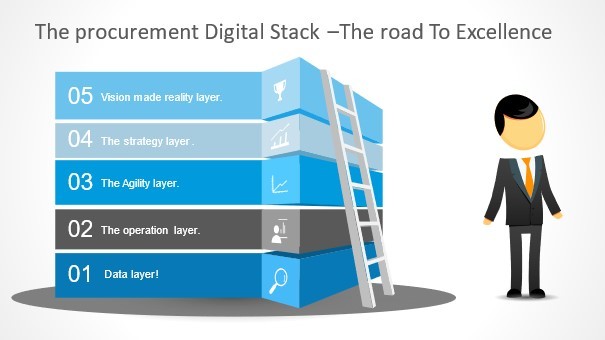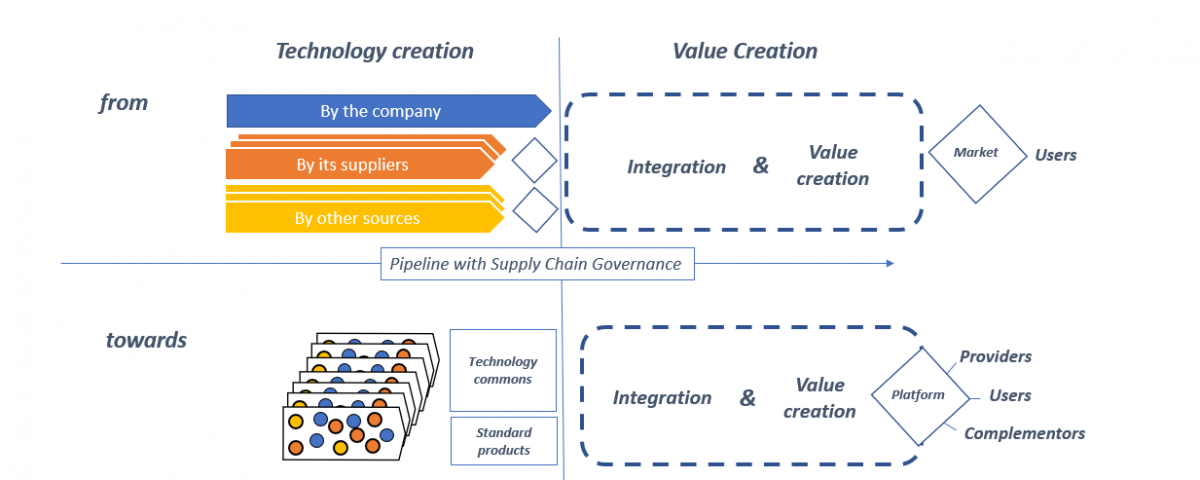On the 31st of August and 1st of September 2021 the EIPM CPO Roundtable was hosted by Capgemini. This was a great opportunity to discover and share on the state of the art for procurement digital solutions. We talked about many topics including the move to cloud, automation, user experience and carbon emissions.
One of my main lessons learned from the two days is the need to adopt a holistic perspective on the procurement digital stack. We can quickly dive in technical details or in specific applications or solutions, but the procurement stack needs to support business performance. We need a vision of how the interconnected activities of machines and humans deliver value for the company and society.
Building on the discussion that we had at the round table, here is an attempt to shape such a vision. It is based of five layers (see figure 1) that we describe underneath.

figure 1: the procurement digital stack
The data layer
During the two days of our CPO roundtable, we had a session on the procurement technology foundations. There was a clear consensus on the need to have a proper vendor data management system that serves as a single source of truth for procurement and other functions. This foundation can then be used in conjunction with different systems, applications, and processes.
In the data layer, in a nutshell, we need Data volume, Data veracity, Data variety, Data velocity and Data Security. We need enough information to leverage business intelligence and business analytics opportunities. We need data that is reliable, secure, easy to trace and assess. We need information that is updated at the right pace in a rapidly changing environment. And finally, we need both company data and external sources of data that allow to enrich the intelligence and services we can get out of our digital assets. Without such foundations it is hard to deliver the final expected value.
One of the challenges highlighted during the roundtable is the lack of standard for simple and recuring data exchanges such as invoices. While today artificial intelligence supports humans to solves this, having a few proper standards for data exchange would make huge impacts and simplify how we work.
The operation layer.
The operation layer focuses on people’s day-to-day experience of the procurement stack. I came back from the roundtable with two main ideas on this layer
The first key idea relates to automation. This is an old truth that we should never loose sight of. Process needs to be first streamlined, cloudified and supported by relevant offshore capabilities before considering further automation opportunities. Using bots is an easy patch that needs to be kept as a last resort solution. If we end up with legacy systems bridged together with a myriad of bots… we have legacy systems that will be even harder to modernize.
The second key idea is that procurement solutions need to be better than your favorite e-commerce platform. For many years, we have heard of that we need an e-commerce like experience. Discussions we had during the roundtable show that this is not enough. On a marketplace, people often enjoy searching for the right solution but in a work context they want immediate access to the solution. Users need a single point of entry that can take them either to a catalogue, to a marketplace or that initiate a request. Simplicity for users is a condition to success today.
Finally, we also discussed the how we can offer some stakeholders access a tool so they can run autonomously a supplier selection. This requires a simple workflow that ensure compliance. While this can be a great solution, simplicity is key and continuous training for new users is required. If this is well implemented, it helps procurement focus on the strategic problems and opportunities of the business instead of loosing time on second order imperatives.
The agility layer
We have experienced a stormy environment over the past two years and one of my key learning is that some digital solutions are first very easy to implement and second, very powerful to navigate these turbulences. During the epidemy, we have seen procurement organisation using algorithms to spot the supplier they needed to work with quickly to anticipate capacity issues. A simple algorithm developed and refined over a couple of weeks was allowing these companies to be three weeks ahead of others for the implementation of contingency plans with suppliers. We have also seen other procurement organisations who developed over a month a financial stress test tool to help some of their supplier understand better their situation. This is quite an important lesson for the future. While some digital initiatives take time, we discussed during the roundtable that other can be rapidly developed and implemented. By rapidly repurposing data and digital assets, companies can create immediate advantages that play an essential role in their success.
The strategy layer
We sometime have a bias. We believe that digital solutions help to automate low value adding tasks. But they can also power strategic activities and create procurement performance breakthrough. If design to cost activities can be performed within one week instead of six; if risk management can be supported by real time multi source information, if carbon emission can be rapidly calculated we do much more than eliminating annoying little stones, we boost the strategic capability of procurement.
During the roundtable, we had very valuable exchange on the carbon emission topic. Companies are centralising and transforming how they calculate and address carbon emissions to reach the zero-emission commitment they have announced. We have seen a lot of opportunities to share and learn as this is a challenge faced by every company. The faster we move forward on this the better!
The vision made reality layer
While we need to continuously sharpen our understanding of digital opportunities, we also need to build a vision of how machines support people, of how they can simplify and enhance the work of buyers, stakeholders and suppliers and deliver better value to clients.
Leveraging data, moving to the cloud, and strengthening digital technology capabilities helps procurement deliver on its vision. It allows to:
· deliver efficient operations and great user experience
· adapt rapidly to contingencies
· solve strategic problems and deliver breakthroughs
it allows to Re-imagine procurement
Join the discussion! Share your views on my post on LinkedIn!
Hervé Legenvre, PhD
EIPM Value Creation Observatory Director
Share this:
- Click to print (Opens in new window)
- Click to share on Facebook (Opens in new window)
- Click to share on LinkedIn (Opens in new window)
- Click to share on Twitter (Opens in new window)
- Click to share on Google+ (Opens in new window)
- Click to share on Pinterest (Opens in new window)
- Click to share on Skype (Opens in new window)
- Click to share on WhatsApp (Opens in new window)




